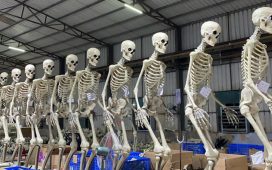R550X autonomous helicopter developed by Rotor Technologies Inc. aimed at handling hazardous … [+]
Hector Xu gave flying helicopters a try but said the combination of the expense and a few “hair raising kind of near miss safety incidents” convinced the former MIT research scientist there was another way to go to more safely pursue his enthusiasm for the rotor craft.
Now, two years after founding Rotor Technologies Inc. in Nashua, N.H. Xu and his 40 or so co-workers are celebrating production of the first two units of what it terms the largest uncrewed civilian helicopter on the market, the R550X.
Hector Xu, CEO Rotor Technologies Inc.
“I think I really just had a strong conviction that technology could could really improve the safety and accessibility of vertical flight,” said Rotor CEO Xu in an interview. “Autonomy has the potential to eliminate about 70% of helicopter accidents. We’re also setting setting the stage for safety across the board even in human-carrying passenger ferry applications.”
Indeed the autonomous R550X is targeted to replace piloted aircraft in a variety of applications where a human could face potentially life-threatening circumstances.
“It’s going to do things like hazardous missions — agricultural application, testing, aerial firefighting, offshore logistics,” added Rotor chief commercial officer Ben Frank in an interview. “Their very first customers are going to come from aerial application crop dusting. That’s the spirit of what we’re going after, these hazardous missions where the helicopter can provide a safety benefit on day one.”
Ben Frank, chief commercial officer, Rotor Technologies Inc.
The single-engine aircraft is built on the platform of the Robinson R44 Raven II, a widely-used helicopter with a strong safety record. By doing so, said Frank, Rotor can focus on developing and installing its autonomous technology and avoids having to go through the lengthy process of winning flight certification.
“We already know this vehicle can fly and it’s already rated to carry around humans,” said Frank.
R550X autonomous helicopter in its hangar at Rotor Technologies.
While there are existing vertical takeoff and landing aircraft, or VTOLs in the marketplace for similar uses in agriculture and firefighting, Xu and Frank point to R550X’s ability to fly further and carry heavier loads.
It has a top speed of 150 miles per hour with a range of about 150 miles and a payload capacity of about 1,200 pounds, “probably 10 times more than any commercial heavy payload drone and matches the useful load capacity of much larger helicopters,” Xu pointed out.
The absence of an onboard pilot doesn’t mean the R550X is completely on its own. A remote pilot, or operator, oversees every flight, although that might change in the future, said Xu.
However, the key technology is the array of sensors and “intelligence” that allows the aircraft and remote pilot to communicate with each other to create situational awareness, say, in the case of aerial firefighting.
One example relates to aerial firefighting that occurs at night. The company says it still requires a pilot with night vision goggles, but those goggles aren’t going to see through the smoke.
Rotor’s technology provides that level of data back to the pilot remotely, which is then allowing the pilot and the helicopter to make decisions in tandem
Rotor is taking pre-orders for the R550X and has several letters of intent in hand. But both Frank and Xu are looking for business to pick up appreciably, eventually in the tens of units per year, just not initially.
“We’re expecting demand to significantly outstrip our ability to produce helicopters in the next 24 months,” said Xu. “We’re not going to be producing tens of the R550X next year and so there’s going to be competition for delivery slots.”
Depending on how it’s outfitted each aircraft costs between $1 million and $2 million, according to Frank.
The privately-held company has been backed by what Xu described as a “high conviction investor who was passionate from day one about our vision and has funded the project so far.”
Rotor is based in a large hangar in Nashua, just north of the Massachusetts state line. For many of its employees, including Xu, the commute requires no air travel, or any travel at all.
“A lot of us live on site. It’s kind of pretty full-on SpaceX style, the development,” said Xu, “When you find really exciting problems that can change the world it’s easy to find motivated and really smart people to work on it.”








